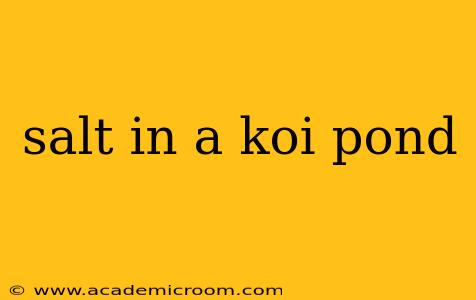Koi ponds, with their vibrant, graceful inhabitants, require careful management to thrive. One question frequently arising among koi keepers is the use of salt. While seemingly simple, the role of salt in a koi pond is nuanced, demanding a careful understanding of its benefits, risks, and proper application. This guide will explore the various aspects of salt usage in koi ponds, answering common questions and providing crucial insights for maintaining a healthy aquatic environment.
Why Add Salt to a Koi Pond?
Salt, specifically non-iodized aquarium salt (sodium chloride), can be a valuable tool in a koi pond's health management. Its primary benefits lie in its ability to:
- Boost the immune system: Salt helps strengthen the koi's slime coat, their first line of defense against parasites and bacterial infections. A healthier slime coat means better resistance to disease.
- Treat parasitic infections: Certain parasitic infestations, such as those caused by Ichthyophthirius multifiliis (Ich), can be effectively treated with salt baths or pond-wide salt additions, following a veterinarian's or experienced koi keeper's guidance.
- Reduce stress: Introducing koi to a new environment can be stressful. A low concentration of salt can help ease this transition and aid acclimation.
- Prevent bacterial infections: While not a direct cure, salt can inhibit the growth of some harmful bacteria.
What are the Risks of Adding Salt to a Koi Pond?
While salt offers benefits, improper usage can be detrimental. Excessive salt levels can:
- Damage plants: Many aquatic plants are sensitive to salt and will suffer or die if exposed to high concentrations.
- Harm beneficial bacteria: The beneficial bacteria crucial for biological filtration can be negatively impacted by high salinity. This can lead to ammonia and nitrite spikes, endangering your koi.
- Stress koi: While low concentrations can be beneficial, excessive salt can stress or even kill your fish.
How Much Salt Should I Add to My Koi Pond?
There's no one-size-fits-all answer. The appropriate salt concentration depends on several factors, including the size of your pond, the number of koi, and the reason for adding salt (e.g., preventative measure vs. treating an infection). Always start with a low concentration and monitor your koi closely. Generally, a concentration of 0.3% to 0.5% is considered safe for most koi. This is typically around 1 pound of salt per 100 gallons of water. Never exceed 0.5% without professional veterinary guidance.
What Kind of Salt Should I Use for My Koi Pond?
It is crucial to use non-iodized aquarium salt. Iodized table salt contains additives that can be harmful to your koi and the pond ecosystem. Avoid using rock salt, Epsom salts, or other types of salt not specifically designed for aquariums.
How Do I Add Salt to My Koi Pond Safely?
- Dissolve the salt: Dissolve the salt completely in a bucket of pond water before adding it to the pond. This prevents localized high concentrations that could harm your fish.
- Add gradually: Introduce the salt solution slowly over several hours to allow your koi to acclimate gradually.
- Monitor water parameters: Closely monitor your water parameters (ammonia, nitrite, nitrate, pH) after adding salt.
- Seek professional advice: If you are unsure about the appropriate salt concentration or are treating a specific condition, consult a veterinarian specializing in aquatic animals or an experienced koi keeper.
What are the signs of salt poisoning in koi?
Signs of salt poisoning in koi can include lethargy, erratic swimming patterns, respiratory distress (rapid gill movement), skin lesions, and ultimately death. If you suspect salt poisoning, immediately perform a partial water change (25-50%) to dilute the salt concentration.
Can I use salt as a preventative measure?
While some koi keepers use low concentrations of salt as a preventative measure to boost the immune system, it's crucial to remember this is not a replacement for proper pond maintenance, including regular water changes, filtration, and a balanced diet for your koi.
Does salt affect my pond's plants?
Yes, high salt concentrations can harm or kill aquatic plants. This is another reason to carefully control the amount of salt added to your pond. Choose plants known for their salt tolerance if you intend to use salt regularly.
This comprehensive guide provides essential information on using salt in your koi pond. Always prioritize the health and well-being of your koi and remember that responsible management is key to maintaining a thriving pond ecosystem. Remember to consult with a professional if you have any concerns or if your koi exhibit signs of illness.
